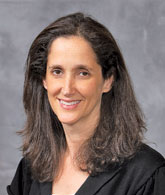 |
Laura Holland, M.D.
Women’s Health Program
Whittier Street Health Center |
A doctor’s point of view
While researchers and physicians have made significant strides in battling breast cancer and developing new treatments to help patients live longer, healthier lives, the deadly disease continues to strike a large number of women throughout the world.
Though both women and men have the potential to develop breast cancer, according to the American Cancer Society, it is 100 times more likely for a woman to be diagnosed with breast cancer than a man, and one out of eight women will develop the disease in her lifetime. Given these statistics, it is important for every woman to understand her individual risks of developing breast cancer and to be aware of preventive measures she can take to minimize her risk.
A woman’s risk for developing breast cancer increases with age; most women with the disease are over the age of 50. In addition, women with a family history of breast cancer as well as certain genetic mutations are at increased risk. Women who begin menstruation at an early age or experience menopause after age 55 are more prone to develop the disease.
“Every woman faces different risks for developing breast cancer, which depends on her genetic makeup and lifestyle choices,” said Laura Holland, M.D., a gynecologist in the Women’s Health Program at Whittier Street Health Center. “Although a woman cannot change her genetic makeup, there are things that she can do to decrease her risk of getting the disease, and there are measures she can take to detect breast cancer at an early stage. I tell all of my patients that they should get annual mammograms after the age of 40. I also instruct them on how to perform self breast examination, and instruct them on the benefits of leading a healthy life.”
For instance, a high intake of fat in the diet and alcohol consumption in excess of one to two glasses per day may increase a woman’s risk for breast cancer. Those who have prolonged exposure to the hormone estrogen, either naturally or as a hormonal replacement, should also be aware of their increased risk of breast cancer.
Though the chances for developing breast cancer are much less likely for men than women, men share similar symptoms, such as a lump or thickening of the breast or changes in the nipple or skin of the breast. Breast cancer that has spread can produce bone pain, weakness and weight loss.
Each person’s treatment plan will depend on her diagnosis and recommendations from her physician. Breast cancer treatments may include chemotherapy, radiation and surgery in varying combinations. If surgery is necessary, a woman may receive either a lumpectomy — the removal of a lump in the breast — or a mastectomy, the removal of the entire breast.
Since it is possible for the cancer to spread to other parts of the body even after treatment, it is imperative to build a relationship with your primary care physician in order to maintain a regular follow-up schedule. Keep your doctor informed about any symptoms or changes that may occur in your health.
“Primary care physicians serve as an important resource to patients when it comes to questions about breast cancer and all issues related to their general health,” said Holland.
|
